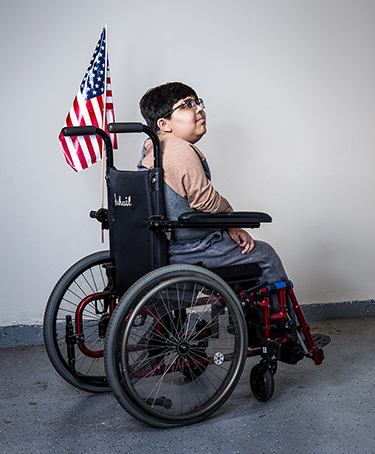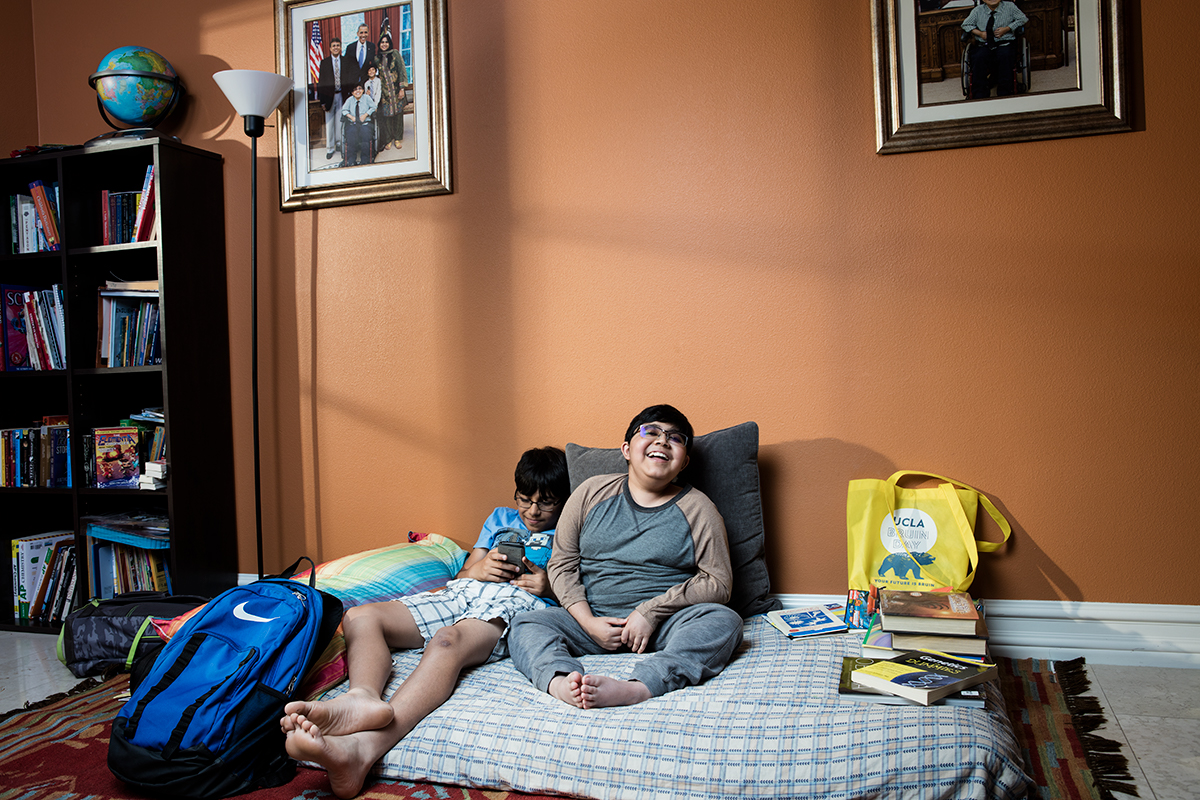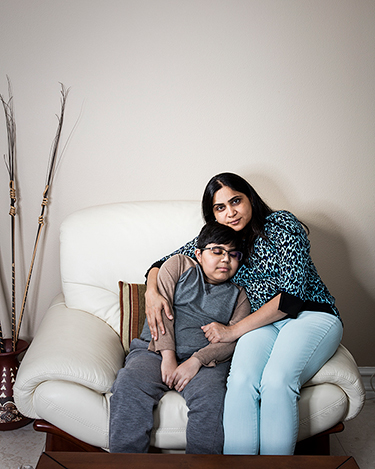Discoveries
For the Boys
Oct 25, 2017 Katie Sweeney
Scientists have struggled for decades to find answers for boys with Duchenne muscular dystrophy, a devastating muscle disorder. But now, new research into cardiac stem cells is offering hope — and going straight to the heart of what cuts patients' lives so short.

The Make-A-Wish Foundation gave Suhail Zaveri this flag and a trip to meet President Barack Obama at the White House. The 18-year-old, who has Duchenne muscular dystrophy, calls the trip his proudest moment. Photo: Max Gerber
Suhail Zaveri was 5 years old when he began to sense that he was different from other kids. He just didn't know how he was different — or why.
All he knew was that he often found himself playing alone in the sandbox. He didn't like to run. And the mean kids bullied him, mocking him for the "weird" way he walked.
But in third grade, he stood up to one of the bullies. After that, no one bothered him. In fourth grade, Suhail was admitted into the gifted and talented education program at school and found a new group of friends. These friends liked him for who he was. They didn't care about the increasingly awkward way he ambled about.
He thought fifth grade would be a great year. Instead, something terrible happened: He lost his ability to walk.
"That's when it hit me, that I really did have a disease," Suhail says. "Every time someone brought it up, I felt like crying. I thought, ‘I'll never be able to be like everybody else. I'll never be normal again.'"
'Shattering'
Suhail has Duchenne muscular dystrophy. He was diagnosed at age 5. At the time, he was too young to understand what Duchenne was. His parents, like most people, had never heard of it.
"When the doctor broke the news, we were like, ‘Is he crazy? What is he talking about? We don't have this in our family. It's not possible,'" remembers Suhail's mom, Asmi Zaveri. But as she and her husband, Sandeep Zaveri, researched the disease, reality sank in — a feeling she can only describe as "totally shattering."
That's a fitting description of a Duchenne diagnosis. The most common form of muscular dystrophy, Duchenne (pronounced doo-SHEN) is a rare and life-threatening genetic disorder that causes progressive muscle degeneration and weakness. It almost exclusively affects boys — about 1 in 3,600 worldwide, with roughly 20,000 patients in the U.S.
The disease has a heartbreaking trajectory. Babies initially appear perfectly healthy. But as they become toddlers and preschoolers, telltale signs begin to appear: a strange gait (such as walking on tiptoes or with feet wide apart), clumsiness, and difficulty climbing stairs and getting up from the floor.
Over time, Duchenne slowly weakens first their legs and arms, and later, their diaphragms and hearts. Most of these boys are in wheelchairs by age 12 (Suhail was 10) and require ventilation support later in their disease. Life expectancy has improved in recent years, but many patients die in their 20s or 30s. There is no cure.
Steroids can slow the progression and are the mainstay of treatment, but they come with side effects and don't halt the disease. And while the gene connected to the disorder was discovered in 1986, the story of Duchenne has long followed a disheartening pattern: success in the lab, followed by failure in clinical trials.
"Almost nothing has translated into human benefit," says Ronald Victor, MD, of the Cedars-Sinai Heart Institute, where he serves as associate director for Translational Research and director of the Hypertension Center. He is also the Burns and Allen Chair in Cardiology Research. "The translational chasm has been so wide. It's tough in every human disease, but it's particularly so in Duchenne. It's just been incredibly frustrating."
I’d had enough of being sad. I wanted to do something about it.”
Suhail Zaveri
But against this discouraging backdrop are signs that the tide may finally be turning. Last year, the Food and Drug Administration conditionally approved the first-ever drug for Duchenne, eteplirsen. Gene-editing technologies, such as CRISPR-Cas9, have shown early promise, too, in repairing the mutation that causes the disease in mice, but a number of practical and ethical roadblocks must be overcome before this idea can be tested in humans.
Now, a clinical trial at the Cedars-Sinai Heart Institute is testing an entirely novel approach to Duchenne: using cardiac progenitor cells (a specialized version of a stem cell) to try to slow or reverse the damage to patients' hearts.
Aptly named HOPE-Duchenne (Halt cardiomyOPathy progrEssion in Duchenne), the study is based on mouse research conducted at Cedars-Sinai — and uses a type of cell therapy pioneered at Cedars-Sinai for the treatment of heart attack patients. The HOPE-Duchenne study goes straight to the heart of what cuts these patients' lives so short.
"Most research has focused on the skeletal muscle aspects of the disease, but, more often than not, the cause of death for these patients is heart failure," explains Eduardo Marbán, MD, PhD, director of the Heart Institute. "Currently, there is no treatment to address the loss of functional heart muscle in these patients."
Could cardiac progenitor cells be the key to altering that landscape — and improving and extending the lives of young men with Duchenne? It's too early to know. But preliminary results in animal models offer hope that stem cells may have the potential to do something astonishing: to heal not only boys' hearts but their limbs as well.
For patients with Duchenne, that's a breathtaking possibility. But something else is remarkable about this research: the way it came about. It wouldn't be happening at all if not for the dedicated efforts of someone who's not a scientist, but a mother — a mother of a son with Duchenne.

Suhail credits a clinical trial at the Cedars-Sinai Heart Institute with giving him more energy — for studying at UCLA and playing video games with his brother and best friend, Arsh (left). Photo: Max Gerber
Seeds of HOPE
The culprit in Duchenne — the cause of so much grief and the reason these boys' muscles get weaker and weaker — is a single missing molecule.
That molecule is a rod-shaped, spring-like protein called dystrophin, which acts like a cushion or "shock absorber" to protect heart and limb muscles from being damaged each time they contract and release. It also acts as a "scaffolding protein," tethering together multiple proteins to help muscles function normally.
Boys with Duchenne have a mutation in the gene that provides the instructions for making dystrophin. The anomaly leaves patients unable to make the protein; it is completely missing from their bodies. In two-thirds of cases, the mutation is inherited from a mother who unknowingly carries it. The rest of the time, it is new.
Without dystrophin, muscle tissue is gradually damaged, replaced by scar tissue and fat. When this scarring occurs in the legs, the boys wind up in wheelchairs. When it happens in the heart, they develop cardiomyopathy (an enlarged and weakened heart) and, eventually, heart failure.
Six years ago, that scarring of the heart was beginning to impact Catherine Jayasuriya's oldest son, Dusty Brandom, then 19.
"You realize there's nothing for the heart," Jayasuriya says. "The boys pass away due to cardiac or pulmonary issues, and there's no treatment for that right now."
So in November 2011, when she came across an article called "Repairing Broken Hearts" in The Economist, she read it with interest. The story detailed efforts by pioneering scientists — including Marbán at Cedars-Sinai — to use cardiac progenitor cells to regenerate damaged tissue in heart attack patients.
"I thought, hey, boys with Duchenne have scarred hearts, too," says Jayasuriya, who with Brandom, co-founded Coalition Duchenne, a nonprofit that focuses on cardiac and pulmonary research in Duchenne and raises global awareness for the disease. "Why not apply the same technology to them?"
A few months later, she got a chance to pitch her idea: At a Duchenne conference, a friend introduced her to Dr. Ron Victor.
Victor had "backed into" muscular dystrophy research because of his interest in abnormal muscle blood flow in Duchenne. He was well aware of the disorder's scientific struggles — and the frustration for families.
Intrigued by Jayasuriya's premise, Victor agreed to arrange a meeting with Marbán. "The truth is, Cath [Jayasuriya] hounded me for months, and I'm glad she did. This is a layperson who deserves a lot of credit for the research," Victor says.
"Part of me was like, I'm being a little too forceful here," Jayasuriya adds. "But then I thought, ‘No! This is for the boys! We need to pursue this.'"
Her persistence paid off: At the end of 2012, she and her husband, Neil Brandom, sat down with Marbán and Victor at Cedars-Sinai.
Marbán had just published his groundbreaking study showing that heart attack patients who received heart progenitor cells experienced a significant reduction in the size of the heart muscle scarring. He already knew that Duchenne patients might be good candidates for treatment with the same cells, but had thought those studies would be down the road.
Jayasuriya changed his mind. Marbán agreed to start the lab studies, and Coalition Duchenne provided the critical funding. Soon, the research was underway.
The Other Side of the Moon

“He is a go-getter,” Suhail’s mom, Asmi Zaveri, says. “When he makes up his mind, he does not give up.” Photo: Max Gerber
On a warm July afternoon, Suhail, now 18, sits at the kitchen table at home in Anaheim Hills. His two grandmothers — who spend half the year in India and half with Suhail's family — shuffle quietly around the kitchen, making lunch. A couple of pots simmer contentedly on the stove; the smell of Indian spices fills the light and airy room.
A lot of people helped Suhail break out of the depression that overwhelmed him in fifth grade, after he lost the ability to walk. People like his fifth-grade teacher, who gently encouraged him to open up. His friends at school, who stuck by him. His younger brother and best friend, Arsh. His grandmothers and other extended family.
Most of all, he credits his parents, who by then were past their grief and were focused on finding the best treatments — and making their lives the best they could be, even with Duchenne.
"I'd had enough of being sad," Suhail says. He leans forward, his dark eyes determined and intense behind his glasses. "I wanted to do something about it. So I got interested in genetics — in what my disease really was. I went online and learned about it: X disorder, chromosomes, introns, exons. Everything. As much as I could."
School became his refuge. He'd always been an excellent student, but now he threw himself into classes and homework with a vengeance. Yes, Duchenne had weakened his body. But his mind was strong. He could think. He could learn. He could study genetics, become a scientist, and do research not only on Duchenne but other diseases as well.
In high school, he enrolled in the International Baccalaureate program, an extremely rigorous academic path. He set his sights on the college of his dreams — UCLA — and got in.
"He is a go-getter," his mom says. "When he makes up his mind, he does not give up."
In 2013, he decided he wanted to meet the president. Through the Make-A-Wish Foundation, he and his family met Barack Obama at the White House. It was one of Suhail's proudest moments.
There are tough moments, too. Duchenne is hard. Suhail gets frustrated when he drops things, or when he can't do something. "I don't get sad; I get angry," he says. "Sometimes I yell at people. Sometimes I say things I don't mean. I want to work on that."
Still, he has come to feel that his disease is also responsible for good things: meeting the president, studying hard to get into UCLA, finding a passion for genetics.
"I feel like there's another side to it, not just a negative side," he explains. "It's like the other side of the moon: one's light, one's dark. The negative can't exist without the positive."
These days, his arm function is limited, but he can still do things like write, eat, and use his phone. The biggest looming problem? His heart. He now has the beginnings of cardiomyopathy.
"The main thing is the heart," Suhail says. "If you can keep it from getting ruined, you can live a long time."
Tiny Bubbles
If you try to imagine how cardiac progenitor cells could repair a heart, you might envision those cells taking root deep in a damaged organ — and then, over time, sprouting new, healthy tissue.
But you would be wrong. Instead, something not so glamorous happens to those stem cells soon after they're injected: They die.
That's what happened when Mark "Amin" Aminzadeh, MD — then a postdoctoral fellow in Marbán's lab — injected millions of cardiac progenitor cells into the hearts of mice with Duchenne in 2013. A week later, Aminzadeh could find neither hide nor hair of those injected cells.
Unexpected? Nope. A disastrous failure? Hardly.
It was quite the opposite: The mice were getting better. After three months, their hearts were pumping more strongly and they could walk much longer on a treadmill — a sign that, possibly, the progenitor cells had helped their hearts and their limbs.
But how could the cells have done anything when they died so quickly?
"We think it's mainly the effects of whatever is secreted by the cells after the injection," explains Aminzadeh, now a second-year medical resident at Cedars-Sinai.
Among those key substances are something called exosomes — tiny, membrane-enclosed "bubbles" that act like messengers, transporting critical cargo to cells. These little "medicinal packets" contain small pieces of genetic material called microRNAs.
"Exosomes appear to contain the signaling information needed to regenerate healthy heart tissue," Marbán notes. "They are naturally able to permeate cells, and they have a coating that protects their payloads as they shuttle from cell to cell. We have found that they are crucial mediators of stem cell-based heart regeneration."
That’s the nice thing about stem cells. It’s one treatment, but it can attack multiple pathways.”
— Ronald Victor, MD
Indeed, when researchers repeated their studies in Duchenne mice — this time injecting only exosomes, not the cardiac stem cells — the mice showed the same improvements.
It was exciting news; the preclinical studies had been a success. But, of course, rodents with Duchenne have been helped before. The trouble has been translating that to humans.
Why has it been so hard? One theory is that the mouse model is not comparable enough to the human disease. New animal models recently have been studied. Funding is another problem: Duchenne doesn't receive as much research attention as more common diseases like diabetes and cancer.
Many early attempts at gene therapy also failed, as the technology was in its infancy. The large size of the dystrophin gene means thousands of different mutations are possible, too.
And then, there is the complexity of Duchenne itself.
"It's a tough disease because it affects so many different organ systems and because it's progressive," notes John Jefferies, MD, MPH, the principal investigator for the HOPE trial at Cincinnati Children's Hospital. "Some of the other [genetic] diseases may level off, but Duchenne keeps progressing, even in the face of steroids." Jefferies is director of Advanced Heart Failure and Cardiomyopathy at Cincinnati Children's Hospital and is Suhail's cardiologist.
Victor, the principal investigator of the HOPE trial at Cedars-Sinai, adds that too much past research has focused on single pathways.
"This is a virulent disease that's probably going to require a multi-pronged approach," he notes. "That's the great thing about cell therapy. It's one treatment, but it can attack multiple pathways at once."
Hearts and Limbs
In the summer of 2016, Suhail was one of 24 patients who enrolled in the Phase I HOPE trial — and one of 13 randomly selected to receive treatment.
At Cedars-Sinai, a catheter was inserted into Suhail's heart, with 75 million cardiac-derived stem cells from donor hearts injected directly into his coronary arteries.
The trial took place at Cedars-Sinai and two other centers — Cincinnati Children's Hospital and the University of Florida Powell Gene Therapy Center. Patients were followed for one year.
The investigators have analyzed data from study subjects six and 12 months after they received the cardiac cells, with encouraging results on safety and efficacy. A manuscript describing these early results has been submitted and is under review for publication, and a larger study is being planned. "We are hopeful that subsequent phases will show results in heart and motor function similar to what we saw in mice," Victor says.
But why would cardiac stem cells injected in the heart have any impact on the limbs, in mice or humans?
The answer goes back to those "tiny bubbles" — the exosomes that stem cells secrete. Researchers believe those exosomes then travel through the bloodstream, enabling them to deliver their healing cargo to cells outside the heart.
Investigators are quick to caution that it's early days; more study is needed in additional patients and a larger, double-blinded Phase II trial is in the works for 2018.
That trial will test an IV infusion of cardiac stem cells, instead of the catheter procedure, to directly target both heart and skeletal muscle. Infusions also would allow for repeated treatments — something that might help benefits last longer.
"If we had a therapy that not only could help the heart, but also improve skeletal muscle function, that would be a game-changer," Jefferies says.
The X Factor: Why Girls Don't Get Duchenne
Duchenne muscular dystrophy primarily affects boys for a simple reason: The genetic mutation only occurs on the X chromosome. Because girls have two X chromosomes, even if one has the mutation, their bodies usually ignore it and only activate the “good” X in the pair. But a boy only has one X chromosome. If it has the mutation, he will have Duchenne.
‘I Am Not Scared'
Coalition Duchenne has continued to fund Marbán's research at Cedars-Sinai. But Dusty Brandom, now 24, couldn't participate in the HOPE trial. His severe, Duchenne-induced scoliosis prevented him from undergoing the study's required MRIs.
Jayasuriya was disappointed, but philosophical.
"What you learn from Duchenne is patience," she says. "We've been waiting for something to come along for many years. It's good news, then bad news. Good news, bad news.
"I know there will be a treatment," Jayasuriya adds. "There will be a cure one day. Dusty and I see the big picture. This is about helping the boys who will come after him, too. I just feel that this is his legacy. And no matter what happens, he truly made a difference."
It's now been a year since Suhail received his stem cell injection. Although he didn't notice any arm improvement — his function is already quite limited — he has more energy. He's also sleeping better. And he can get through a tough day of classes without the exhaustion he used to feel.
That energy comes in handy now that he's a freshman at UCLA. He's majoring in microbiology, immunology, and molecular genetics and plans to pursue a PhD.
He and his parents continue to hope for new treatments. "I am not scared," Asmi Zaveri says. "I have no doubts there will be a cure. Everything can't fail."
Suhail, meanwhile, is focused on college, his friends, and playing video games with his brother (they play as a team). He remains grateful for the good things in his life.
"I feel lucky," he says. "My family has supported me a lot; they've always been there for me. That's a major part of why I'm not upset anymore: I don't feel alone.
Disclosure: The cardiac derived cells (CDCs) used in the Phase I HOPE trial were derived from donor hearts and provided by Capricor Therapeutics. Marbán developed the process to grow CDCs when he was on the faculty of Johns Hopkins University; the process was further developed at Cedars-Sinai. Capricor has licensed the process from Johns Hopkins and from Cedars-Sinai for clinical and commercial development. Capricor has licensed additional intellectual property from Cedars-Sinai and the University of Rome. Cedars-Sinai and Marbán have financial interests in Capricor. Victor has served as consultant for the sponsor but has not received payment for these services.


